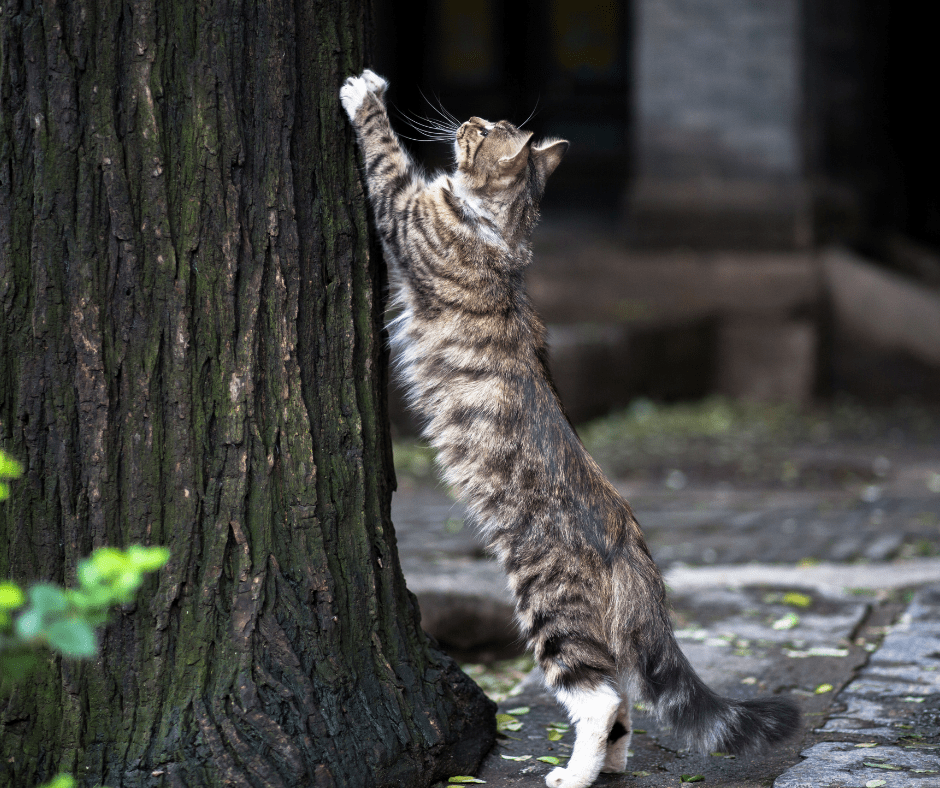Osteoarthritis in Cats

Osteoarthritis is a very common condition in cats, particularly as they age. Despite being a very painful disease, it often goes unnoticed until it has become very advanced. Cats are very good at hiding their discomfort and they have often been struggling for some time before their diagnosis.
We’re going to explore what osteoarthritis is and the signs to look out for in your cat. We will also explore the best ways to help your cat manage their condition and how you can keep an eye on your cat’s quality of life.
What is osteoarthritis?
Osteoarthritis is also known as degenerative joint disease (DJD). It is a progressive condition where the shock-absorbing cartilage at the end of the bones in joints becomes worn and uneven. The once smooth, gliding surface of the joint becomes roughened and damaged, leading to pain and inflammation. Eventually the bones within the joint begin to rub against each other, leading to further inflammation and thickening of the joint.
Osteoarthritis can affect just one joint or multiple, depending on the underlying cause. As mentioned, osteoarthritis is progressive meaning that it will get worse over time. The condition cannot be cured, but there are lots of things that can be done to help manage your cat’s pain, improving their quality of life.
What causes osteoarthritis in cats?
In cats, osteoarthritis can be caused by several things including:
- Age – years of wear and tear can contribute to joint disease.
- Obesity – increased weight puts more pressure on joints, leading to greater wear and tear.
- Genetics – some cats are more prone to developing osteoarthritis than others, including some breeds with cartilage abnormalities such as the Scottish Fold cat.
- Damage to a joint – trauma to a joint can cause damage to it, leading to arthritic change.
- Developmental abnormalities – conditions like hip dysplasia lead to abnormal joint formation, increasing the risk of osteoarthritis.
What are the symptoms of osteoarthritis in cats?
Cats are absolute masters of hiding problems, including pain, so symptoms may be very subtle to begin with. As time goes on, and the condition worsens, these signs may become more obvious.
Cats with osteoarthritis may suffer from one or more of the following:
- Limping.
- Stiffness, especially after resting.
- Sleeping or resting more than usual.
- Loss of body condition – reduced muscle mass can lead to weaker legs and more pronounced bones.
- Difficulty jumping up onto high places.
- Less interest in playing or hunting.
- Matted, unkept fur due to difficulty grooming, especially around their rear end and back.
- Using the scratching post less, leading to overgrown claws.
- Change in temperament, becoming grumpier or withdrawn.
- Reacting negatively when painful joints are touched.
- Not going outside as much as usual.
- Difficulty getting in the litter tray or through the cat flap.
- Toileting accidents.
How is osteoarthritis diagnosed in cats?
There is still some way to go for both owners and vets in recognising signs of osteoarthritis in cats. Some scientific research helps to demonstrate just how underdiagnosed this condition is in cats. One study went as far as to show that 9 out of 10 cats aged over 12 years had evidence of arthritic change, despite the condition only being reported in about 4% of these cats. This is why it is so important to be familiar with the symptoms.
During an examination, your vet should be looking out for physical clues. Loss of muscle condition, over-long claws and a matted coat may be seen. Your vet will also feel and manipulate your cat’s joints to assess for any inflammation, stiffness, crepitus (grating in the joints), and signs of pain. Watching the way your cat moves around the room can also be helpful.
Your vet will also discuss any signs you might have spotted at home, such as difficulty jumping, behavioural changes, or toileting accidents.
Depending on their findings, your vet may recommend taking X-rays to assess your cat’s joints further. This can help to determine the severity of any arthritic changes but also helps to rule out other issues. One of the main issues is that changes on X-rays can be subtle, so even if nothing much is seen, your vet may still trial treatment for arthritis to assess your cat’s response.
Your vet may choose not to take X-rays if other signs are clear, opting instead for starting a course of pain relief medication and seeing if this works. If it is successful and your cat improves, then arthritis is the likely cause of their pain.
Attending regular vaccination appointments or senior clinics can help to detect osteoarthritis sooner, as well as keeping an eye on other health complaints as your cat ages.
What are the treatment options for cats with osteoarthritis?
While there is no cure for osteoarthritis there are plenty of things that can be done to improve your cat’s quality of life and slow the progression of the disease. A combination of the treatment options listed below and adjustments in the home usually gives the best outcome in the majority of cases. This is known as a multi-modal approach to osteoarthritis management.
Pain relief and anti-inflammatory medications
Your vet may prescribe pain relief medication to make your cat more comfortable. Non-steroidal anti-inflammatory drugs (NSAIDs), like meloxicam, are commonly used. They not only provide pain relief, but they also reduce inflammation. Your vet might advise taking a blood sample from your cat to check their liver and kidney function before using this medication longer term.
Monoclonal antibody injections can also be very helpful in many cases. They work by interrupting the transmission of pain signals, making your cat more comfortable. These monthly injections save you from giving daily medication at home, and they can also be used safely in cats with underlying organ dysfunction.
Other drugs such as gabapentin and tramadol may be used in cats with chronic pain issues.
Joint supplements
Joint supplements (nutraceuticals) contain the building blocks needed for healthy cartilage. Rich in glucosamine, chondroitin and omega-3 fatty acids, these products can be used safely in most cats. There are also joint diets available that are already fortified with these ingredients, which may be easier than remembering to give an additional supplement.
Weight management
Obesity puts extra strain on already damaged joints. If your cat is overweight, your vet may suggest a weight loss regime which could make a massive difference to their symptoms. There is a lot of evidence showing that weight loss can be as effective as painkillers for overweight arthritic patients!
Additional therapies
There are some complementary therapies which may be helpful for cats suffering from osteoarthritis. Physiotherapy is an example of this. It is a type of physical therapy using targeted exercises to improve movement and build muscle in affected animals.
Hydrotherapy is a low-impact exercise that takes place in water. This helps to improve the muscles supporting your cat’s joints while the water helps to support their weight. However, some cats are not happy going in the water, so this tends to be more commonly used in dogs.
Acupuncture might be a pain-relief option for very laid-back cats. You must always use a qualified veterinary acupuncturist and see if they will visit your home environment to keep things as relaxed as possible for your cat.
Surgical management
There are some cases where surgical intervention could be useful, especially where medical management is not helping. Your vet will discuss this with you depending on your cat’s condition.
Whatever combination of treatment is used, regular check-ups are usually advised so your vet can ensure your cat’s joint issues are well managed. These appointments also make sure that no other health concerns are developing.
What things can I do to help my cat at home?
As well as prescribed medications and therapies recommended by your vet, there are several things you can do to improve your cat’s home environment. By making a few small adjustments you can help your cat feel more comfortable and make performing their daily tasks easier. Here are a few things to try:
- Provide a low-sided litter tray to make toileting easier. Stepping up into a deep litter tray can be difficult for cats with osteoarthritis, leading to toileting accidents.
- Provide steps or ramps to help them get up onto things without needing to jump, e.g. onto your bed or the sofa.
- Raise their food and water bowls if your cat struggles with bending down.
- Offer a few different comfortable beds in various locations of the house that they can easily access.
- Provide a pet-safe heated bed or heat pad, as some arthritic cats find this comforting.
- Give them regular grooming sessions to keep nails trimmed and stop their coat from matting.
- Encourage moderate amounts of gentle exercise to maintain muscle mass and stop weight gain.
- Avoid giving treats or table scraps to your cat, especially if they are on a weight-loss diet.
Quality of Life
When managing your cat’s osteoarthritis, you must always consider their quality of life. If your pet can do the things they normally enjoy, like exercising, playing, and eating, then these are all good signs. If, however, your cat is having increasing numbers of bad days, then this needs to be questioned. Sleeping more and losing interest in play may be a sign that your cat is in pain, not that they are just getting old or ‘slowing down’ as many owners believe.
Speaking with your vet is important, as there may be alternative treatment or management techniques that can help improve the situation. But if you feel you have exhausted all the options or if you are no longer able to cope emotionally or financially with your cat’s health problems, then euthanasia may be the kindest option.
If you are struggling to know what to do, then have a look at our ‘Is it time?’ page. We have a checklist that you can work through which will help you to assess your cat’s quality of life in more detail. You can also get in touch with one of our care co-ordinators.
Summary
Osteoarthritis is a very common problem in senior cats and one that will continue to progress over time. Fortunately, there is a lot we can do to help our cats feel more comfortable. Your vet will discuss the best treatment for your cat, but even making a few adjustments around the home could make a massive difference. Make sure you attend regular check-ups with your cat and keep a close eye on their quality of life.
We understand that there may be a time when either you or your pet are no longer able to cope with their health complaint. Please don’t hesitate to contact your vet if you have concerns about your pet, or you can talk to one of our care co-ordinators about our peaceful at-home euthanasia visits.
Cloud 9
To ensure accuracy, a professional vet has reviewed and verified the information presented in this article. It is important to note that when it comes to making decisions about euthanasia for your pet, there are no easy answers. It is always recommended to seek advice from your own veterinarian before making any decision.


